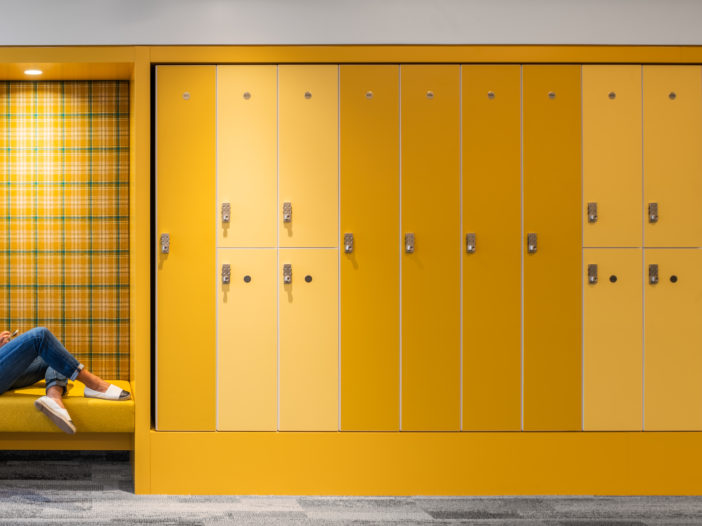
As elite professional environments become more WeWork-like, luxury lockers are the new offices.
But wait: aren’t lockers just metal boxes with doors for throwing your stuff into? How did “locker design” even become a thing?
According to Travis Hollman, it all started with Tiger Woods.
It all started with Tiger Woods.
“Golf was on fire [in the late 1990s] because of Tiger, and country clubs were upgrading their golf courses left and right,” he says. “They wanted wooden lockers that looked like cabinetry.” When furniture-makers couldn’t deliver—wood warps and splits in the wet environment of a locker room—companies like Hollman began capitalizing on the new demand for luxury lockers that could take an athletic beating while looking fabulous. Two decades later, Hollman controls 70% of the “nonmetal” portion of this billion-dollar locker market (“only high schools and government entities buy metal lockers anymore,” he says) and helps sports teams recruit talent with $12,000 lockers equipped with video monitors, device charging stations, and motorized shelves.
Rather than just retailing a catalog of mix-and-match prefab storage boxes (although they do that, too), Hollman brands itself as a high-end interior architecture designer that creates bespoke, commissioned solutions that fit individual clients’ needs. Hospitals, spas, and museums—places where people need to store their stuff without feeling like they’re entering a public pool or surrendering personal items in a jail—followed suit. “It just kind of transformed over the years from a basic business to what it is today,” Hollman says.
But why offices?
Again, an unexpected trend caught Hollman’s attention. Call it “WeWork-ization.”
“About four years ago, we started seeing this new office concept enter the mainstream,” he says. “Open spaces, open floor concepts, hot desks, people coming and going, but also collaborating. We said, ‘This is going to be the next wave.’”
In other words, the same financial and social pressure that has driven corporations to fit more warm bodies into the same square footage by killing cubicles and installing phone booths has also created a demand for haute employee lockers.
“I was just up at JP Morgan in Delaware, and they went from 1,200 people to 2,100 people in the same space,” Hollman says. “Most employees get a four- or five-foot flat desk with two monitor screens on it that you plug [a laptop] into. There is no space for your personal belongings. There’s nothing there for you. It’s just this desk. So how we look at it is, a locker is the only space you have now in most of these places that’s your own—so we need to give you something that is extraordinary.”
“a locker is the only space you have now in most of these places that’s your own—so we need to give you something that is extraordinary.”
Hollman isn’t the only workplace locker-maker with a high-end image. Luxer One presents itself with a startup-like, design-centric attitude, but their lockers are designed to replace your mailbox, not your desk. Spacestor sells lockers “designed for the millennial mind” (their words), but they only offer one off-the-rack product as part of a larger suite of WeWork-esque furnishings. Longhorn Lockers designs soup-to-nuts custom locker rooms, but only for athletic clients. If Hollman has positioned itself as the Apple of its own niche industry, it’s hard to find another company trying to be Android.
Hollman wants it to stay that way, and he says his eponymous firm has an active R&D department. It develops antimicrobial and anti-fingerprint surfaces for its units and a velvet-like, “soft-touch material” called NanoLam. “There’s a big push for this in the marketplace—people aren’t getting enough [physical] interaction, because they’re on their phones so much,” he says.
Luxury locker design has to be on-brand, too.
At Nike, Hollman-made luxury lockers have chalkboard or whiteboard exteriors, so employees can customize them (with humblebrags about the latest workout they crushed, perhaps). Google asked for flashy red glass “that looks like ‘high tech,’” says Hollman. At Goldman Sachs, lockers are a stately white with double-decker personal filing cabinets underneath.
So where is luxury locker design—corporate, athletic, or otherwise—headed next?
The answer will hardly shock you.“It’s going to come down to using these luxury lockers to data-mine the workplace,” Hollman says. “They’re going to want to know what locker you’re using, how long you use it”—and link that information with other data about desk usage, logins on company computers, and anything else that’s trackable. That data could be used by a company to “help adapt the work environment to make employees more happy,” says Hollman. Or surveil them to enforce performance regimes. You know, whichever.
“It’s going to come down to using these lockers to data-mine the workplace”
Either way, Hollman cites the rise of indoor cycling “platform” Peloton as an analogy to where his business is headed, whether he likes it or not. “Peloton is worth $4 billion—more than every health club company in America put together—and it’s because everybody that’s riding one is putting their data into it,” he says. “It has nothing to do with the bike. And I think in the future, [our business] might not have anything to do with the lockers. It’s going to have to do with the data you can get out of them.”
“It has nothing to do with the bike. And I think in the future, [our business] might not have anything to do with the lockers. It’s going to have to do with the data you can get out of them.”
Source: Fast Company
RELATED ARTICLES:






